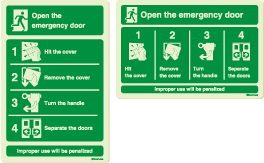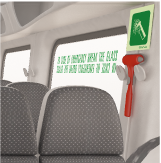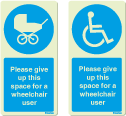Regulation no. 107 for Buses and Coachs
|
Uniform provisions concerning the approval of category M2 or M3 vehicles with regard to their general construction, adopted by the European Union, set uniform technical prescriptions for wheeled vehicles, equipment and parts which can be fitted and/ or be used on wheeled vehicles. The importance of the use of safety signs on board vehicles covered by Regulation 107 is addressed in chapter 7.6.11 Safety Signs.As its designation pertains, the UNECE Regulation 107 is applicable to vehicles classed as: M2: vehicles used for the carriage of passengers, comprising more than eight seats in addition to the driver’s seat, and having a maximum mass not exceeding 5 tonnes. M3: vehicles used for the carriage of passengers, comprising more than eight seats in addition to the driver’s seat, and having a maximum mass exceeding 5 tonnes. Annex 3 sets the provisions that must be met by all vehicles within these categories. Namely in respect of safety signs as established in chapter 7.6.11. Safety Signs: 7.6.11.1. All safety signs shall comply with requirements contained in paragraph 6.5 of ISO standard 3864-1:2011. ISO 3864-1: 2011 specifies the safety identification colours and design principles for safety signs that are to be used with the objective of preventing accidents and to convey safety messages related to fire-fighting, health hazard information and emergency evacuation:
a) The colour white includes
the colour of photoluminescent material on daylight and in accordance with the
provisions of ISO 3864.4 Even though this part of Regulation 107 is specific to paragraph 6.5, Safe condition signs, of ISO 3864-1:2011, this should be interpreted as a demonstrative effort and the overall specifications of ISO 3864-1:2011 in terms of colours and shapes for the different category of safety signs should be taken in to account in the design of safety signs compliant to this requirement. Implementing the overall ISO 3864-1:2011 principles will have a positive contribution in conveying an effective safety message to the users of public transportation in general, and consequently of these classes of vehicles. Implementing the overall ISO 3864-1:2011 principles will have a positive contribution in conveying an effective safety message to the users of public transportation in general, and consequently of these classes of vehicles. 7.6.11.2. Each safety sign required by this Regulation shall be used to communicate only one safety message. The information provided shall be in the form of pictograms, however, words, letters and numbers may supplement the pictogram in combination on the same sign. It shall be located and orientated so as to be easily understood. 7.6.11.2.1. Safety signs shall follow the principles shown in the example layouts below, i.e. a header section depicting the safety message, a second section containing instructional information and a third, optional, footer section for non-critical text.  The examples provided above follow the principles laid out by paragraphs 7.6.11.2.1 and 7.6.11.2 as both signs are comprised with pictorial graphics and supplementary texts and contain a header section with the general contextualisation of the safety message as well as a section with instructions that must be followed. Both examples also contain a third section with non-critical text. Additionally, the two sign examples given also follow what is prescribe by the subsequent paragraphs 7.6.11.2.2, 7.6.11.2.3, 7.6.11.2.4 and 7.6.11.2.5: 7.6.11.2.2. Pictograms indicating required actions by the user shall show a person, or the relevant part of a person, operating the equipment or device. 7.6.11.2.3. Pictograms indicating a required movement shall, where appropriate, show an arrow pointing in the direction of motion. Where a rotational movement is required, a curved arrow shall be used. 7.6.11.2.4. Where devices are to be operated, doors are to be opened or panels need to be removed the pictogram shall indicate the action in progress. 7.6.11.2.5. The lower case letter(s) of supplementary words, single letters and numbers shall have a minimum height of 8 mm. Words shall not be in upper case letters only. Regulation 107 also addresses the nature of safety signs that are to be used not only in terms of their general characteristics but also in terms of their quality performance which will be crucial in the event of an emergency. In this respect, this chapter specifies the use of photoluminescent safety signs and set their minimum luminance requirements: ISO 17398: 2004 prescribes the requirements for performance based classification system for safety signs, namely in terms of photometric properties. ISO 17398:2004 paragraph 5.5 presents the luminance decay characteristics of photoluminescent safety signs and their respective classification:
7.6.11.3 All safety signs that are visible from the inside of the vehicle shall be of photoluminescent material having luminance decay characteristics conforming, as a minimum, to sub-classification C in Table 2 of ISO Standard 17398:2004, when measured in accordance with paragraph 7.11. of that standard. These minimum luminance performance values should be obtained by submitting the signs to the luminance measurement test specified in paragraph 7.11 as referred by Regulation 107. There are a wide variety of photoluminescent safety signs available in the market place with equally diverse luminance performance and therefore establishing a minimum quality benchmark that is accepted for this market is crucial in assuring that the vehicles are equipped with the right products. The Everlux signs offered in this catalogue meet all the requirements and will help you in assuring compliance as well as in offering an effective safety signage system to passengers and staff onboard.  The location of where the safety signs are installed is also an important factor in assuring that they will be effective when needed. This matter is addressed in Regulation 107 in paragraphs 7.6.11.4, 7.6.11.5, 7.6.11.6 and 7.6.11.7: 7.6.11.4. Safety signs shall not be located in positions where they may be obscured during operation of the vehicle. However, a curtain or blind may be positioned over an emergency window provided an additional safety sign indicates that the emergency window is located behind the curtain or blind. 7.6.11.5. Each emergency exit, and any other exit that meets the prescriptions for an emergency exit, shall be marked by one of the relevant pictograms described in Table 3 of ISO Standard 7010:2011; pictograms shall be legible from both the inside and the outside of the vehicle. Apart from specifying how emergency exits shall be marked, paragraph 7.6.11.5, is also important as it prescribes the use of pictograms in compliance with ISO 7010: 2011. Graphical symbols - Safety colours and safety signs – Registered safety signs contains a comprehensive catalogue of signs developed in accordance with the design principles established by ISO 3864 that are to be used in for accident prevention, fire protection, health hazard information and, in this particular case for emergency evacuation:  7.6.11.6. Safety signs shall be positioned adjacent to, or surround, or be on, all internal and external emergency controls and device(s) for breaking emergency window(s).  7.6.11.7. No part of a safety sign shall obscure any misuse protection that may be present, e.g. a cover. As referred in paragraph 7.6.11.2., safety signs shall be comprised with pictograms and may be supplemented with words and text to increase the comprehension of the message conveyed by a particular sign. In paragraph 7.6.11.8, regulation 107 establishes that the language used in supplementary texts shall be determined by the approving authority of country where the vehicle is intended to be used on: 7.6.11.8. The language in which any textual safety sign intended to comply with paragraphs 7.6.11.1. to 7.6.11.7. above are to be inscribed shall be determined by the approving authority bearing in mind the country / countries in which the applicant intends to market the vehicle in liaison if necessary with the competent authorities of the country / countries concerned. If the authority of the country / countries where the vehicle is to be registered has the language changed, this change shall imply no new type approval process. The last paragraph of chapter 7.6.11. Safety Signs addresses the need of safe condition signs to mark devices that enable passengers to indicate that the driver should stop the vehicle: 7.7.9.1. On vehicles of Classes I, II and A, a means shall be provided to enable passengers to signal that the driver should stop the vehicle. The controls for all such communication devices shall be capable of being operated with the palm of the hand. (…)  Additionally to the specific chapter for Safety Signs that was covered above, the UNECE Regulation 107 further indicates that safety signs can be proposed in accordance to chapters that are dedicated to other equipment. For example, paragraph 7.8.3.1 requires that the activation of the emergency lighting system can be done from the driver’s seating position. Thus, the use of a photoluminescent safety sign identifying the activation mechanism of the emergency lighting position can prove to be valuable during an emergency situation.  In fact, the provisions made by the regulation for the accommodation and accessibility of passengers with reduced mobility also prescribe the use of signs developed in accordance to ISO 3864 design principles: 5.2. Vehicles of Class I shall be accessible for people with reduced mobility, including at least one wheelchair user and one pram or unfolded pushchair according to the technical provisions laid down in Annex 8. 12 the area for the accommodation of an unfolded pushchair or pram. In such a case, the area shall have signs fixed on or adjacent to the area with the following text, equivalent text or pictogram: "Please give up this space for a wheelchair user”. 3.7.3. For vehicles of Classes I, II and A, where the foot space of any seat, or part of a folding seat when in use, intrudes into a wheelchair space, those seats shall have signs fixed on or adjacent to them with the following text, equivalent text or pictogram: "Please give up this space for a wheelchair user”. The provisions of paragraph 7.6.11.4. of Annex 3 apply to any textual markings used”.  3.7.4. In vehicles where any wheelchair space is designated for use exclusively by a wheelchair user as provided for in paragraph 7.2.2.2.10. of Annex 3, those spaces shall be clearly marked with the following text, equivalent text or pictogram: "Area designated for use exclusively by a wheelchair user”  We are confident that this coverage of the UNECE Regulation 107 will be useful for public transportation sector who all are responsible for assuring safety signage compliance and welcome any questions on this regulation or ony any other relevant Standards on safety signs. For inquiries please e-mail us at commercial@everlux.com. To access the complete technical sheet, please go page Downloads |
|||||||||||||||||||||||||||||||||||||||||||||||||||||||||||||||||||||||





